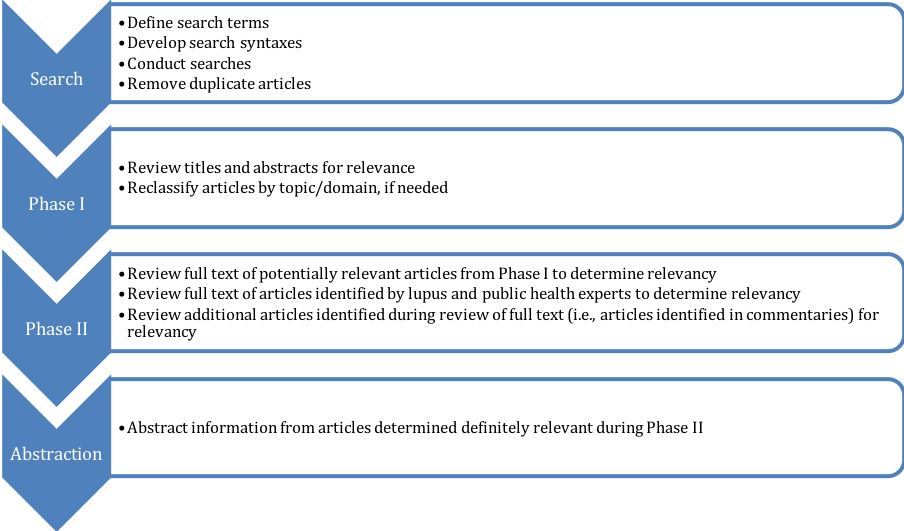A LITERATURE REVIEW IN SUPPORT OF
A NATIONAL PUBLIC HEALTH AGENDA FOR LUPUS
BACKGROUND
In 2014, as work at lupus registries funded by the Centers for Disease Control and Prevention (CDC) was nearing an end, CDC recognized a need to provide the larger public health community with a roadmap for the next generation of lupus activities. Previous work in lupus had been focused on biomedical and clinical research. Very little work had been focused on the public health perspective of lupus, such as improved community-clinical linkages, environmental/policy changes, evidence-based approaches to self–management, or risk reduction factors for specific populations.
NACDD worked closely with the Lupus Foundation of America (LFA) and CDC to develop the 2015 A National Public Health Agenda for Lupus (link), which provides a broad public health approach to lupus diagnosis, disease management, treatment and research, and serves as an overall blueprint for action in lupus to help guide future policy, planning, advocacy and action initiatives.The six priorities, 15 strategies and 63 recommendations set forth in the Agenda are intended to complement efforts in lupus biomedical research and clinical care.
LITERATURE REVIEW
This supplement to A National Public Health Agenda for Lupusdescribes a systematic review of the public health literature on lupus, which was not fully available at the time the Agenda was being created. It is offered now as a starting point for those interested in pursuing some of the recommendations of the Agenda.
NACDD contracted with SciMetrika to conduct a systematic review of the public health literature on lupus that might be relevant to addressing lupus from a public health perspective.
Exclusion criteria
We excluded articleson lupus that addressed only biomarkers, language validation of a survey (not English validation), and clinical diagnosis, were published before 1990, orwere editorials on another article (the articles discussed in the editorials, if relevant, were added to the review).
Inclusion criteria. We sought retrievable, peer reviewed articles from 1990 through 2015that addressedlupus and one or more of the following seven topic areas:
1. Burden
o Quality of life (QoL), Health related Quality of life (HrQOl), Lupus Quality of Life (LQoL)
o Health care utilization (e.g., hospitalizations, ambulatory care visits, emergency department visits, etc.)
o Economic costs, economic burden, costs, health economics
o Employment/Occupation, productivity, disability, work outcomes.
o Tools/instruments to assess burden
2. Population incidence overall and by
o Age
o Gender
o Race/ethnicity
3. Population prevalence overall and by
a. Age
b. Gender
c. Race/ethnicity
4. Comorbidities
a. arthritis, cardiovascular disease, depression, diabetes, obesity
5. Disparities
a. Health insurance
b. Race/ethnicity
c. Income
d. Access to care
e. Treatment
6. Access to care
a. Supply of rheumatologists
b. Distribution of rheumatologists
c. Primary care health professional shortage areas
7. Public health
a. Prevention
b. Risk factors
Burden, incidence, prevalence, and access to care were limited to US studies, while race/ethnicity, comorbidity, disparities, and public health were not limited by country.
Overall Methodology
Search terms were defined and search syntaxes developed for each topic area to find articles of potential interest. Syntaxes were tailored for each database searched (PubMed, EMBASE, PsycINFO, and the Cochrane Library).
SciMetrika identified 2,038 articles of potential interest. After eliminating duplicate articles, 1,541 were reviewed using a two-phase approach to determine relevancy of the articles for each topic area.
Phase I reviewed titles and abstracts of the resulting articlesfor potential relevancy, and added articles to additional topic areas if the article was deemed potentially relevant.
Phase II was a full text review of articles determined to be potentially relevant during Phase I.Additional articles suggested by lupus and public health experts or identified during the review of full text were also reviewed in Phase II.
The relevant information from the articles determined to be definitely relevant during Phase II wasentered into an Excel spreadsheet during Abstraction. This spreadsheet includedcitation information, topic/domain area(s), target population, sample size and characteristics, study objective, methodology, results, and conclusions and recommendations.
Figure 1: Literature Review Process

Findings
The 253 articles found to be definitely relevant included 223 original research studies, 18 reviews, 49commentaries/nonsystematic reviews, and one symposium summary. The 253 articles contributed 292 citations for the seven required topic areasbecause some articles were relevant to more than one topic area.
Table 2: Number of citations for 253 articles, by topic area
|
Topic Area |
Number of citations for 253 articles |
Original Research (197 articles) |
Review (15 articles) |
Commentaries/Nonsystematic Review (40 articles) |
Symposium Summary (1 article) |
|
Burden |
106 |
84 |
9 |
13 |
|
|
Incidence |
11 |
7 |
1 |
3 |
|
|
Prevalence |
8 |
4 |
1 |
3 |
|
|
Comorbidity |
72 |
59 |
3 |
10 |
|
|
Disparities |
51 |
39 |
2 |
9 |
1 |
|
Access to Care |
12 |
11 |
0 |
1 |
|
|
Public Health |
32 |
19 |
2 |
10 |
|
|
Total |
292 |
223 |
18 |
49 |
Back to the Lupus program home page.
